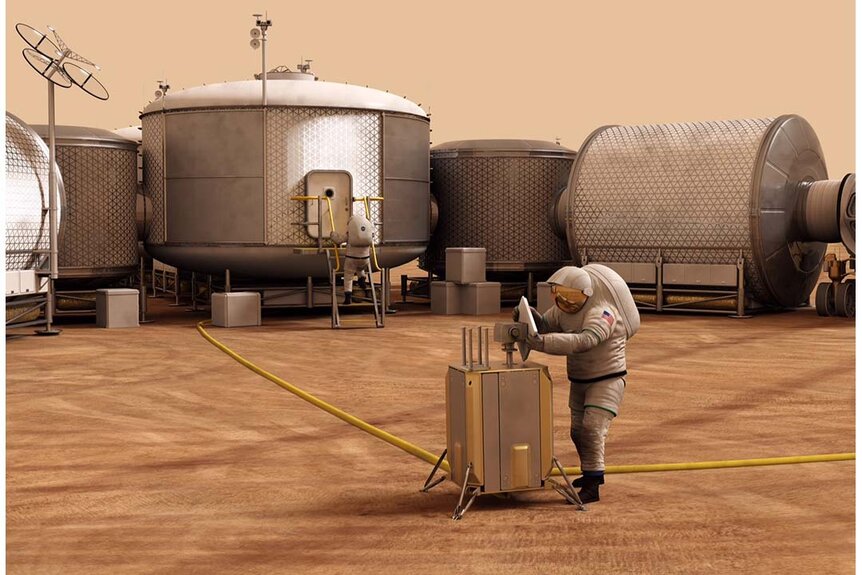Create a free profile to get unlimited access to exclusive videos, sweepstakes, and more!
Meet the Moss That Could Help Terraform Mars
Future Martians might walk on lawns of desert moss.
The crew of The Ark (Season 2 premieres July 17 on SYFY) is ostensibly headed for Proxima centauri b, a (probably tidally locked) exoplanet around a star 4.2 light-years from here. That’s if they survive the trip. If they do, they’ll be greeted by a world which has the benefit of being relatively nearby but is entirely unlike Earth. Living there would probably require underground bunkers along the perpetual boundary between day and night, just for a start.
As far as we can tell, the only planet in the cosmos perfectly tuned to our requirements is the one we grew up on. Which makes sense, evolution tunes all organisms to love the environment they’ve got. If humanity ever wants to walk beneath alien skies without donning a spacesuit or living inside environmentally controlled domes, we’re going to have to change something about ourselves or something about the worlds we find.
While the ethical debate continues about how or if we should interact with other planets (particularly something so extreme as terraforming its environment), scientists have made a discovery that could lay the literal groundwork for transforming the face of Mars.
For More on Mars:
Scientists Are Holding Their Breath for Samples of Fresh Martian Air
A Mission to Mars Could Destroy Astronauts’ Kidneys
Morning Frosts Fill Martian Volcanoes with 150,000 Tons of Water Ice
This Moss Might Be Able to Survive on Mars, and Help People Survive There Too
In a new study published in The Innovation, scientists studied a species of desert moss called Syntrichia caninervis which survived even after going through a gauntlet of simulated Martian conditions. On Earth, S. caninervis has adapted to extreme desert conditions. It’s the dominant species of moss in the Mojave Desert and grows in other extreme desert landscapes including Antarctica. It can withstand intense temperatures (both hot and cold), incredibly dry conditions, and somewhat curiously, high doses of radiation. Through all of that, it can survive and thrive for more than a century.
Study authors call it a “pioneer plant” seemingly capable of growing in at least one alien environment, “laying the foundation for building biologically sustainable human habitats beyond Earth,” the authors wrote. If humanity ever does set up shop on another world, it’s almost certainly going to be Mars. It’s relatively close by and harsh to Earth life, but maybe not overwhelmingly harsh, by cosmic standards.
To be clear, the conditions on Mars suck. They are not conducive to human life even a little bit, but they might be acceptable, just barely, to this tiny species of moss. Those conditions include a wispy little atmosphere, less than 1% the pressure of Earth’s atmosphere at sea level. The atmosphere is made almost entirely of carbon dioxide, about 95%, which isn’t horrible news if you’re a plant. Humans living there would need a much denser atmosphere with a higher concentration of oxygen.
Because it has such a thin atmosphere and because it has only a weak magnetic field, the surface of Mars is bombarded by much higher doses of radiation from space. Something else humans aren’t too fond of, but S. caninervis seems to be fine with.
Temperatures on Mars range wildly from way below freezing to a nice spring day, depending on your latitude, altitude, and time of day. Noontime temperatures at the equator can reach a comfortable 70 Fahrenheit (21 Celsius) while nighttime temperatures at the poles get down to -225 Fahrenheit (-143 Celsius). On Earth, the atmosphere holds onto heat (a bit too much these days) but the thin atmosphere of Mars loses heat quickly. If you were standing at the equator, you’d feel those warm summer temperatures down at your toes, but your head would be freezing, according to NASA.
Back here on Earth, scientists spent months messing with S. caninervis in the lab to see what it could handle. They simultaneously exposed it to an anoxic (oxygen deprived) atmosphere, extreme desiccation (dehydration), low temperature, and extreme radiation.
In one experiment, plants were kept below freezing at -112 Fahrenheit (-80 Celsius) for five years. Others were kept submerged in liquid nitrogen for a month. They all got right back to business as soon as they were thawed. Other plants lost more than 98% of their moisture and recovered photosynthetic and physiological activities in seconds after being rehydrated. No matter what they threw at it, the moss bounced back as soon as conditions got better. On Mars, that could mean that moss in the right location could endure the harsh nighttime conditions and spring back the next day.
S. caninervis could serve as “the basis for the establishment and maintenance of the ecosystem by contributing to oxygen production, carbon sequestration, and soil fertility,” the authors wrote. And, while they note that it could be a keystone species for the future development of a Martian ecosystem, in the meantime it could also be used here on Earth to develop novel plant species capable of better weathering environmental changes. Not bad for a scrappy species of desert moss.
Season 2 of The Ark premieres on SYFY beginning Wednesday, July 17 at 10/9c. Catch up on the entirety of Season 1, streaming now on Peacock!























